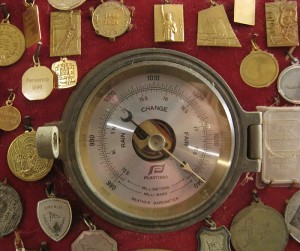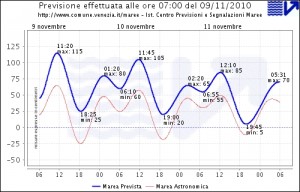I’m sitting here at 7:30 waiting to see what the water is going to do.
This is not the first time this fall that water has come ashore (as it probably will), but it’s the first time I’m taking it slightly more seriously — and by “seriously” I don’t mean I’m pulling the tarps off the lifeboats preparing to abandon ship, so to speak; I mean that I believe that the official prediction may be close to accurate. That alone would be worth writing about.
The accuracy is interesting only for the same reasons that any weather prediction is interesting — Did they get it right? And does this mean I should take future predictions really seriously?
There are several indications that they may be onto something this morning, most of which do not require their intervention because I have the tools at hand to understand and evaluate the probabilities all by my big-girl self.

First, the barometric pressure. It has been impressively low for the last 12 hours, if not more. Low pressure means high water, a rule so simple even I can remember it.
Checking the barometer is one of the first useful things to do, and this is what impressive low pressure looks like. Note that whoever put those generic terms on the instrument’s face (“fair,” “change,” “rain”) didn’t consider putting “impressive high water” in the lower right-hand space. But that’s okay, because depending on where you live they would more usefully have had to put “monsoon,” “tropical cyclone” and other events not likely to occur here. So never mind.
Second, the wind direction. The garbin (gar-BEAN) was blowing strongly from the southwest yesterday afternoon, which is good because it impels the water to move northeast, or out into the Adriatic where it can do whatever the heck it wants to. Then it veered around to the north — even better.
But now it has veered to a scirocco, or southeast wind, which has the opposite effect of pressing the water into the lagoon, as I rustically think of it — or at least of creating enough force to block the tide’s normal retreat.
Third, we are now on the verge of the 24-hour period of the “morto de aqua,” or “death of the water,” when the tidal variation is minimal. This 24-hour period falls twice a month and doesn’t particularly influence the height of the high tide, but it does mean that since the tides are not especially strong, the weather is almost always unstable. Which means don’t count on anything except some kind of unpleasant weather. In the summer we can get huge thunderstorms during the “morto de aqua.”
If I had a shop near the Piazza San Marco and didn’t know any of the above, instead of wailing to the city about paying me for the damage or inconvenience I had suffered, I ought to be paying them for my preposterous ignorance. Hm — that would be an entertaining project: Setting a scale of penalty payments for preposterous ignorance. The mind absolutely sparkles at the thought.
Fourth, if you don’t know any of the above three basic facts of life in the lagoon, you can decide to depend on the city’s system of warning sirens, which sound an hour before water is expected to start rising through the drain system. If you live more than an hour away from San Marco, of course, this system doesn’t do you much good.
Or you might go online and consult the prediction from the city’s Centro Maree, or Tide Center.
It’s interesting to see the variation between the normal tidal flux (the lower, light red line) and the real-time prediction (upper blue line). The only problem with this tool is that its usefulness depends heavily on being updated in a timely fashion.

Really timely updates are available through the text-messaging system. However, if you have signed up with the Tide Center to get the prediction via your cell phone, you still might want to consider a fall-back position. A few days ago the Gazzettino reported that thousands of users had indeed received the necessary warning, but only several hours too late. The city blamed the mobile phone company and its incapacity to send thousands of simultaneous text messages. (Oh good — something even less dependable than weather predictions: cell phone efficiency). The city has since — they say — changed companies.
I have not signed up with this service because, well, we’ve got the barometer, which is incapable of lying and doesn’t depend on any human agent whatsoever. What a scintillating thought that is.
Update: The sirens have just sounded. And instead of the two tones which “code orange” would require, there was only one tone, meaning the maximum ought to be a mere 110 cm (43 inches)above normal sea level, not the earlier prediction of 115 cm (45 inches). This doesn’t mean they were wrong, it just means that something changed. Whatever it was, I’m for it. Two inches makes an inordinate amount of difference..

4 Comments
Venetians must get so tired of the high water and all the problems that come with it. Keep watching that barometer, and the wind direction.
Ciao.
Not any tireder than anybody anywhere when some weather event puts a crimp in the morning’s plans. We can go for weeks without high water; there was one winter when I never put my boots on once. Anyway, it’s on the ground for so short a time that it’s kind of pointless to get tired of it, because it’s going to be gone really soon. The people who are really inconvenienced are the barge and taxi drivers who can’t get under the bridges, and the riders on certain vaporettos whose routes have been altered for the same reason, for one or two hours. But the eruptions of Mt. Merapi — to pick a catastrophe at random — or the extinction of tigers or human trafficking are much bigger problems than high water in Venice. I’m sure everybody realizes that.
Erla,
Are those Lino’s rowing/participation medals surrounding the Barometer? Could you post a wider shot. Come this June I will have 5!!
Thanks,
Tim
Those are just a few of the medals he has won or been awarded, either as a racer himself, or as a race judge, or for his participation in some major foreign boating events. I will post a wider shot. He also has trophies, cups, and many, many pennants (given to the first four finishers in a race, each a different color).